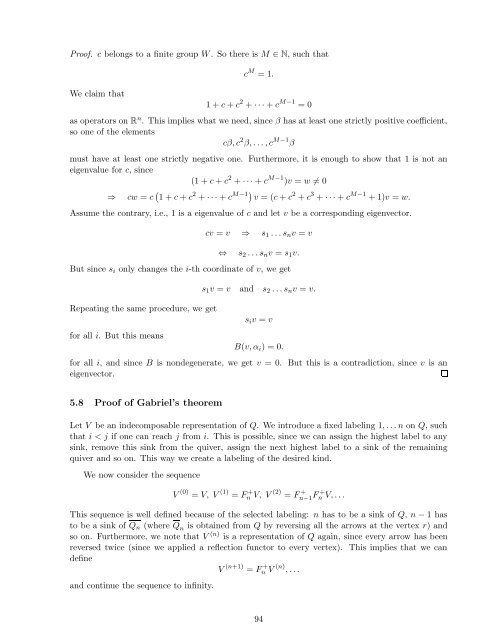Lecture notes for Introduction to Representation Theory
Lecture notes for Introduction to Representation Theory
Lecture notes for Introduction to Representation Theory
You also want an ePaper? Increase the reach of your titles
YUMPU automatically turns print PDFs into web optimized ePapers that Google loves.
Proof. c belongs <strong>to</strong> a finite group W . So there is M N, such that<br />
We claim that<br />
c M = 1.<br />
1 + c + c 2 + · · · + c M−1 = 0<br />
as opera<strong>to</strong>rs on R n . This implies what we need, since α has at least one strictly positive coefficient,<br />
so one of the elements<br />
cα, c 2 α, . . . , c M−1 α<br />
must have at least one strictly negative one. Furthermore, it is enough <strong>to</strong> show that 1 is not an<br />
eigenvalue <strong>for</strong> c, since<br />
(1 + c + c 2 + · · · + c M−1 )v = w ⇒= 0<br />
2 2 3<br />
≥ cw = c ⎩ 1 + c + c + · · · + c M−1 v = (c + c + c + · · · + c M−1 + 1)v = w.<br />
Assume the contrary, i.e., 1 is a eigenvalue of c and let v be a corresponding eigenvec<strong>to</strong>r.<br />
cv = v<br />
≥<br />
s 1 . . . s n v = v<br />
⊆ s 2 . . . s n v = s 1 v.<br />
But since s i only changes the i-th coordinate of v, we get<br />
Repeating the same procedure, we get<br />
<strong>for</strong> all i. But this means<br />
s 1 v = v and s 2 . . . s n v = v.<br />
s i v = v<br />
B(v, ϕ i ) = 0.<br />
<strong>for</strong> all i, and since B is nondegenerate, we get v = 0. But this is a contradiction, since v is an<br />
eigenvec<strong>to</strong>r.<br />
5.8 Proof of Gabriel’s theorem<br />
Let V be an indecomposable representation of Q. We introduce a fixed labeling 1, . . . n on Q, such<br />
that i < j if one can reach j from i. This is possible, since we can assign the highest label <strong>to</strong> any<br />
sink, remove this sink from the quiver, assign the next highest label <strong>to</strong> a sink of the remaining<br />
quiver and so on. This way we create a labeling of the desired kind.<br />
We now consider the sequence<br />
V (0) = V, V (1) = F n + V, V (2) = F n−1 + F n + V, . . .<br />
This sequence is well defined because of the selected labeling: n has <strong>to</strong> be a sink of Q, n − 1 has<br />
<strong>to</strong> be a sink of Q n (where Q n is obtained from Q by reversing all the arrows at the vertex r) and<br />
so on. Furthermore, we note that V (n) is a representation of Q again, since every arrow has been<br />
reversed twice (since we applied a reflection func<strong>to</strong>r <strong>to</strong> every vertex). This implies that we can<br />
define<br />
V (n+1) = F + n V (n) , . . .<br />
and continue the sequence <strong>to</strong> infinity.<br />
94

















